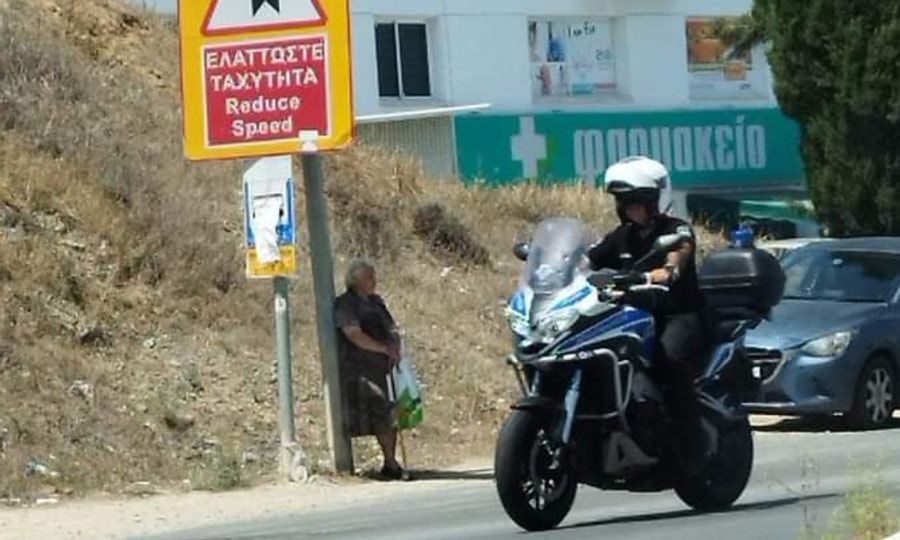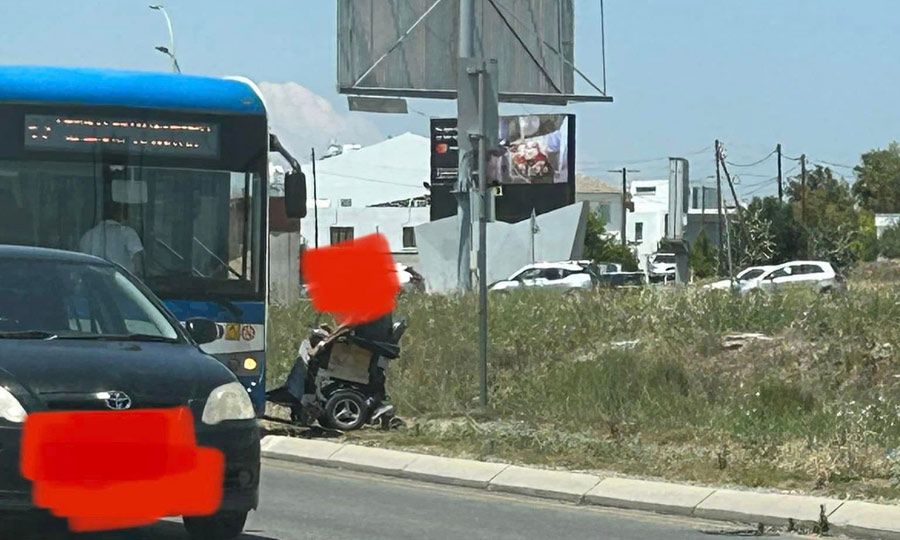
Ioanna Kyriakou
Pictures that have come to light in recent days have stirred up a wave of anger. One shows an elderly woman waiting for the bus at a shelterless stop in the July heat, leaning on a lamppost and holding her cane and shopping bags in her hands. In another instance, a person in a wheelchair is seen boarding a bus from a stop located in a field. In light of the above, "K" contacted both the Ministry of Transport and the Union of Municipalities in order to document their perspectives and the measures being developed to tackle the problem of deficiencies in public transportation.  An elderly woman at a bus stop without shelter or a bench.
An elderly woman at a bus stop without shelter or a bench.
A budget of €2,500
Aristotle Savas, Executive Engineer at the Department of Public Works, proposed an immediate solution. During an interview with "K," Savvas highlighted the ongoing Shelter Subsidy Scheme in Communities and Municipalities, which has been funded by the state budget since 2017. The primary objective of this scheme is to develop shelters and essential infrastructure in areas with urgent needs. Under the program, the Ministry of Transport, Communications, and Works provides a maximum subsidy of EUR 2,500, including VAT, per shelter. However, if the cost of a shelter exceeds this amount, typically in the case of specialized shelters such as those made of stone or wood or upgraded types, the Municipality assumes the additional cost beyond the subsidy. Conversely, if the cost is lower, it is paid in proportion to the actual expenses incurred. A person in a wheelchair boards a bus from a bus stop in a field.
A person in a wheelchair boards a bus from a bus stop in a field.
In response to the issue, Andreas Vyras, President of the Union of Municipalities, shared his perspective. When asked for his comment on the public outcry regarding the bus stops, Vyras stated in an interview with K that municipalities, when facing immediate needs, should utilize their budgets to address the problematic areas. He emphasized that it is the responsibility of each individual municipality rather than the Union of Municipalities as a collective entity. Furthermore, Vyras encouraged residents to report any stops that require improvement. When questioned about the responsibility for identifying and reporting problematic stops, he referred to the bus companies, which he noted are responsible for determining the routes, although they operate independently from the Union of Municipalities.
The €60 million project
Simultaneously, there is a €60 million project underway to enhance bus stops and shelters across the country. The project will be executed through a 5-year contract, and a tender has been initiated using a two-stage procedure comprising a prequalification stage and an award stage. Additionally, the contract includes provisions for 10 years of maintenance. A model placed in Leof. Makarios III, in the center of Nicosia.
A model placed in Leof. Makarios III, in the center of Nicosia.
The project has a budget of €60,000,000.00 plus VAT and is allocated as follows:
- €35,000,000.00 plus VAT for a 5-year implementation phase.
- €5,000,000.00 plus VAT for a 10-year maintenance phase.
- €10,000,000.00 plus VAT for the contracting authority's right to additional orders.
- €10,000,000.00 plus VAT for other entities' right to place orders.
The project is co-financed by the European Regional Development Fund THALIA (65%) and national resources (35%).
It is important to note that the grant project will run concurrently with the nationwide bus suspension and rack upgrade project. Any infrastructure developed under the subsidy scheme will contribute to addressing existing needs more efficiently. Another model set up in Leof. Makarios III, in the center of Nicosia.
Another model set up in Leof. Makarios III, in the center of Nicosia.
What it includes
The project encompasses various aspects related to the construction, installation, and repair of bus stops and shelters throughout Pancyprian. These include:
- Construction of 350 Smart Stops (pillar design)
- Installation of 1350 new small shelters
- Installation of 650 new large shelters
- Installation of 100 new large roofs suitable for mountainous areas
- Repair of 600 existing large shelters, followed by their repositioning on secondary routes. New shelters will be placed in their current locations.
- Repair of 400 existing large roofs in their current locations
- Installation of 2000 simplified stops
- Integration of photovoltaic systems
- Placement of 500 electronic signs
- Installation of 450 baskets
- Provision of 200 bicycle racks and 20 cycle racks
- Foundation construction and sidewalk repairs around the stops
These measures aim to improve the infrastructure and functionality of bus stops and shelters across the region. Another model placed on Leof. Makarios III, in the center of Nicosia.
Another model placed on Leof. Makarios III, in the center of Nicosia.
Types of bus stops
Savvas emphasized that the primary focus of the comprehensive project lies on the main thoroughfares in cities with high passenger traffic. He further mentioned that in certain locations, the necessity of a shelter will be assessed, considering factors such as limited space or the presence of stops within historical cores. The design of these new stops and shelters takes into account the local conditions and available space within the road network. The aim is for the new shelters to incorporate features such as accessibility for disabled individuals, safety measures, weather protection, utilization of renewable energy sources, scalability to meet user needs, adequate lighting, and electronic signs with audible announcements indicating bus arrivals at the stops.
From left to right, the different types of stops and shelters can be described as follows:
1. Pillar-Type Stop (first from left):
These are installed when there is insufficient space for a shelter or when there is minimal usage of the sign by passengers.
2. Medium-Sized Canopy (second from left):
These canopies are placed in areas where there is limited space for a large shelter. They are suitable for locations with a smaller number of users or other constraints, such as obstruction of nearby shops, homes, or other developments.
3. Large Canopies (third and fourth from left):
These larger canopies are designed to be used on major routes and areas with high passenger traffic. In upland areas, the canopies provide additional weather protection, as depicted in the photo on the top left.
The variety of shelters caters to different circumstances and ensures suitable coverage for various locations and passenger demands.
The standard samples
To test and enhance the design and materials, as well as to showcase sample structures to potential bidders for the new stops and shelters, three prototype models were constructed and installed along Arch. Makarios III Ave. in the heart of Nicosia. These samples serve the purpose of evaluating and refining the design before full-scale implementation.
The selection criteria for determining the type of stop/shelter are as follows:
1. Passenger traffic, assessed by analyzing sales data obtained through the "MOTION" Telematics System.
2. The physical condition of the infrastructure at each location, evaluated during the comprehensive survey conducted on stops nationwide.
3. Consideration of the commerciality of areas and local priorities.
These criteria are taken into account to ensure that the appropriate type of stop/shelter is chosen for each specific location, taking into consideration passenger demand, infrastructure conditions, and local priorities.
[This article was translated from its Greek original]
































